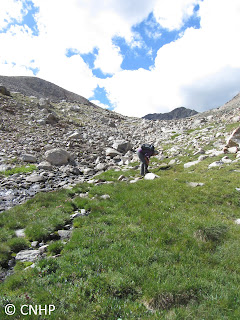We were fortunate to have projects in three national parks on the west slope this year: Dinosaur N.M., Black Canyon N. P. and Mesa Verde N.P. In Dinosaur during our June trip we documented Erigeron wilkenii, E. nematophyllus, Oenothera acutissima, Oxytropis besseyi ssp. obnapiformis and several Pellaea glabella occurrences. In July, due to the low water in the Yampa River, we were able to wade (sometimes swim) across the river and access the north side, where we found some wonderful alcove seeps with Adiantum capillis-veneris, Anticlea vaginata, Limnorchis zothecina and Cirsium ownbeyi.
 |
| An alcove seep in Dinosaur National Monument. |
It was so hot that every time we came back to the river from a foray up a canyon, we jumped right in.
 |
| CNHP botanist Peggy Lyon coolin' off in the Yampa. |
In Black Canyon N.P. we established permanent monitoring protocols for Sullivantia hapemannii and Gilia penstemonoides. This year’s drought really affected two other targeted species, Astragalus anisus and Thelypodiopsis juniperorum. For the latter we found more dead plants from 2011 than living ones.
 |
| CNHP botanist Dee Malone in Black Canyon National Park. |
In Mesa Verde Peggy with Park Service botanist Merran Owen found large new populations of Hackelia gracilenta, Astragalus deterior and Lepidium crenatum.
 |
| Botanist Peggy Lyon in front of ruins in the Mesa Verde National Park. |















crop.jpg)


